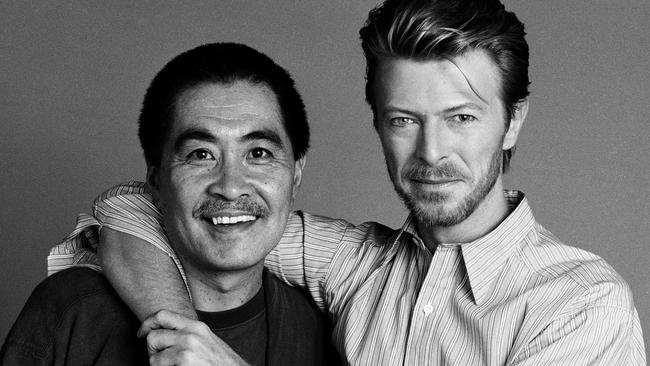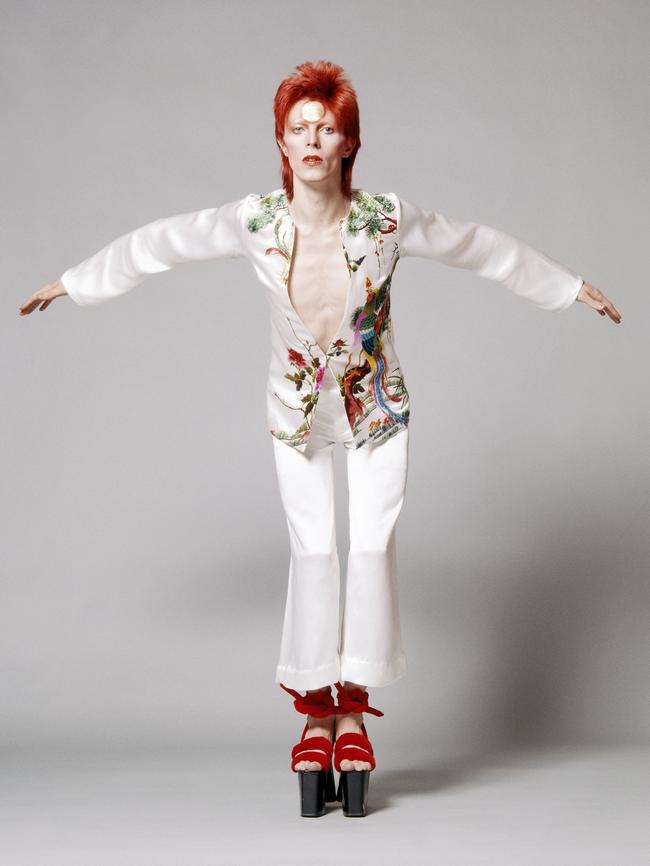Shooting the Starman
Masayoshi Sukita snapped David Bowie for four decades.

It was one of those insignificant moments that changes the course of a lifetime.
Ambitious young photographer Masayoshi Sukita had leftJapan in the early 1970s to immerse himself in the Andy Warhol-dominated arts scene in New York.
Soon enough he found himself in London, chasing down musicians to add to his studio portfolio.
“A few days after I finished shooting [Marc Bolan’s band] T. Rex, I spotted a poster in the street that turned out to be advertising the David Bowie concert,” says Sukita. “I asked around and so many people said he was the rising star, everyone was intrigued by David Bowie. So I went and showed my portfolio and requested that I shoot him in a studio, and he agreed.”
Sukita, 80, is speaking with a translatorover Skype from his office in Tokyo about that career-defining moment and the genesis of his 40-year creative relationship with Bowie, which is the subject of an exhibition at the Head On Photo Festival opening in Sydney next month. Softly spoken with a short white bristly beard, he seems an unlikely fit for his experience — a man who would capture some of the biggest names in music, from Iggy Pop to Bowie and Jimi Hendrix.
Was he surprised Bowie agreed to that initial shoot?
He smiles. “No. I wasn’t.”

By that point in his career he had a substantial portfolio in Japanese fashion magazines and television commercials and had won many industry awards. Then there’s the fact that he didn’t know just how big the young Bowie would become.
“When I first shot David Bowie, I had no idea what sort of musician he was,” Sukita says. “Primarily I just wanted to increase my portfolio in men’s fashion. The day I shot him, he had already had another shoot earlier in the day with David Bailey, the famous photographer. In the late afternoon he came to our rental studio.”
Sukita couldn’t speak English, but it didn’t matter. They’d find, he says, their own language through the camera
“Only once in a while I engaged an interpreter, but most of the time I didn’t need one because photographing someone face to face is two artists collaborating with each other,” Sukita says. “He had enormous curiosity and interest in the world and a skill of cultivating deep and wide communication beyond language.”
It would be the first of more than 20 shoots the pair would collaborate on around the globe over the course of nearly four decades.

In the early 1970s Bowie started collaborating with another Japanese artist, fashion designer Kansai Yamamoto who together with Sukita would become a common ingredient in many of his best-known images.
Just before a concert at the Radio City Music Hall in New York in 1973, a “quite enthusiastic” Bowie arrived for a shoot with Sukita in concert makeup and wore Yamamoto’s white suit featuring an oriental design — the first of many outfits by the designer who would dress the singer for his Ziggy Stardust and Aladdin Sane tours. That shoot resulted in Starman (1973) and the Watch That Man series of images, that unforgettable black billowing jumpsuit against the red background.
Meanwhile, Sukita’s relationship with the West was growing, and although he continued to live in Japan, he travelled to London and New York for up to three months at a time, sleeping on friends’ couches and taking photos.
When Bowie and Iggy Pop visited Tokyo in 1977 off the back of the latter’s album The Idiot, Sukita documented the trip. One of the images would go on to become the famous cover of Bowie’s Heroes album.
No matter where they were, Sukita took the same approach, arriving without a predetermined concept. “A 50-50 relationship between the photographer and the subject is ideal,” Sukita says. “Of course, with Bowie sometimes the balance tips to him and sometimes it tips to me. In a way it’s like [playing] catch-ball.”
One of the rare occasions on which Sukita presented a brief was after Bowie had starred as a British soldier captured by the Japanese during World War II in the 1983 film Merry Christmas, Mr Lawrence. “I saw a photo of him growing a beard for the first time. I thought: he is young, he is cool and he is smart, and some kind of maturity was added,” he says.
Sukita immediately called Bowie “and told him not to shave because I wanted to take a close-up photo of his face. He said OK, and I travelled to New York straight away.” The photographer purchased a copy of Japanese composer Ryuichi Sakamoto’s soundtrack for the film and gave it to Bowie as a present.
“David put it in the record player so the music was playing,” Sukita says. “I set up the camera and asked him to stare into the lens for 10 to 15 minutes, so I was able to capture just a very minute or subtle shift of his facial expression.”
“I imagine he was thinking about World War II and maybe he was going through the memory of the film shoot.”
Their final collaboration was in New York in 2009.
“I shot him at his officebecause I didn’t have much time,” Sukita says. “My photo was the last page of his photo album, published in England, and soon after that he fell sick and, unfortunately, I didn’t have another opportunity.”
When Sukita exhibited a collection of his Bowie photographs at the Morrison Hotel Gallery in New York in 2015, he invited Bowie to attend. “I had no idea how sick he was.”
Bowie died on January 10, 2016, after an 18-month battle with cancer. He was 69.
Sukita has dreamed of exhibiting in his home town of Nogata, a former mininghub in Fukuoka on Kyushu Island. As well as preparing to come to Sydney for his exhibition, he’s putting together a photographic meditation on water in all its forms: from clouds, mist, rivers and asteroids. (He enthusiastically notes that the Japanese recently sent a spacecraft, Hayabusa2, to the asteroid Ryugu.)Although Sukita no longer gets calls from rock stars asking him to shoot their album covers, his eyes light up with an ageless enthusiasm at a new musical connection to his currentfascination.
“I didn’t know until recently that [Queen guitarist] Brian May was a scientist,” Sukita says with a chuckle.
“He congratulated the Japanese satellite team for conducting or making the discovery.”
Rock ’n’ Roll Heroes, a retrospective of the work of Masayoshi Sukita, is at Paddington Town Hall in Sydney from May 4 to 19 as part of the Head On Photo Festival.




To join the conversation, please log in. Don't have an account? Register
Join the conversation, you are commenting as Logout